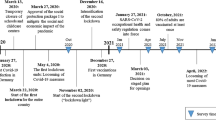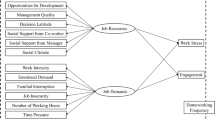Abstract
This paper investigates how working from home affects employees’ work effort. Employees who have the possibility to work from home have a high autonomy in scheduling and organizing their work and are therefore assumed to have a higher intrinsic motivation. Thus, we expect working from home to positively influence work effort of employees. We introduce a theoretical model that analyzes whether intrinsic motivation influences the impact of working from home on employees’ work effort. To account for the self-selection into working locations, we use an instrumental variable (IV) estimation strategy. Our empirical results indicate that working from home has a positive influence on employees’ work effort. In addition, we show that working from home indeed increases intrinsic motivation and thus employees’ work effort. Moreover, we find that the frequency of working from home also matters. The more frequently employees work from home, the higher the work effort they provide is.

Similar content being viewed by others
Notes
For further information on the SOEP, see Wagner et al. (2007).
Monthly earnings up to a threshold of 400 euros (450 euros since 2012) characterize German “mini-jobs”. Employees who have a “mini-job” are socially subsidized. For instance, they do not need to pay the employee contribution to the pension insurance system.
Table 10 in the appendix shows how many observations were excluded in each step.
In this case, all communication with colleagues and clients is through information and communication technologies (Bailey and Kurland 2002).
We distinguish between the sixteen German federal states.
The dataset provides information on employees’ working location in the 1997, 1999, 2002, and 2009 waves. We decided to use the working location in 2002 as an instrument because this information is closest to that for 2009.
In the dataset, we only have information on employer-provided computers or laptops in the 2006 and 2008 waves. Because the motivational impact of fringe benefits received in 2008 might influence employees’ work effort one year later, we use information on employer-provided computers from 2006.
A reason for over-reporting working hours is that individuals might want to give socially desirable responses. Another possible explanation might be that individuals have problems recalling the exact timing of last week’s working hours (Robinson et al. 2011), or employees might over-report their actual workload because they aim to receive a promotion.
For instance, employees who report 40 actual working hours per week overestimate their real working hours by 2 h on average (Robinson et al. 2011). Therefore, in this example, we correct employees’ work effort by subtracting 2 h from their reported actual working hours.
For the robustness checks, we exclude the interaction term (\(\textit{WFH}\times \textit{IM}\)) from Eq. 2.
Bartel (1995) argues that investments in human capital increase employees’ productivity. At the same time, the investment in human capital leads to a wage growth. Therefore, wages are an appropriate proxy for measuring employees’ productivity.
Another explanation for the empirical results than the crowding-out of motivation might be that distinct incentive schemes induce different degrees of dishonesty (e. g., Erat and Gneezy 2012). Thus, the observed different impacts on reported work effort in specifications (1) and (2) might be more strongly related to the payment regime than to the working location or employees’ motivation.
References
Bailey, Diane E., and Nancy B. Kurland. 2002. A review of telework research: findings, new directions, and lessons for the study of modern work. Journal of Organizational Behavior 23:383–400.
Bailyn, Lotte. 1988. Freeing work from the constraints of location and time. New Technology, Work and Employment 3:143–152.
Bartel, Ann P. 1995. Training, wage growth, and job performance: evidence from a company database. Journal of Labor Economics 13:401–425.
Baruch, Yehuda. 2000. Teleworking: benefits and pitfalls as perceived by professionals and managers. New Technology, Work and Employment 15:34–49.
Beckmann, Michael, Thomas Cornelissen, and Matthias Kräkel. 2017. Self-managed working time and employee effort: theory and evidence. Journal of Economic Behavior and Organization 133:285–302.
Bélanger, France. 1999. Workers’ propensity to telecommute: an empirical study. Information and Management 35:139–153.
Bell, Linda A., and Richard B. Freeman. 2001. The incentive for working hard: explaining hours worked differences in the US and Germany. Labour Economics 8:181–202.
Bloom, Nicholas, James Liang, John Roberts, and J. Ying Zhichun. 2015. Does working from home work? Evidence from a Chinese experiment. Quarterly Journal of Economics 130:165–218.
Cadsby, C. Bram, Song Fei, and Francis Tapon. 2007. Sorting and incentive effects of pay for performance: an experimental investigation. Academy of Management Journal 50:387–405.
Davidson, Wallace N., III, Biao Xie, Weihong Xu, and Yixi Ning. 2007. The influence of executive age, career horizon and incentives on pre-turnover earnings management. Journal of Management and Governance 11:45–60.
Deci, Edward L., and Richard M. Ryan. 1985. Intrinsic motivation and self-determination in human behavior. New York: Plenum.
Dohmen, Thomas, Armin Falk, David Huffman, and Uwe Sunde. 2009. Homo reciprocans: survey evidence on behavioural outcomes. Economic Journal 119:592–612.
DuBrin, Andrew J. 1991. Comparison of the job satisfaction and productivity of telecommuters versus in-house employees: a research note on work in progress. Psychological Reports 68:1223–1234.
Dutcher, E. Glenn. 2012. The effects of telecommuting on productivity: an experimental examination. The role of dull and creative tasks. Journal of Economic Behavior and Organization 84:355–363.
Erat, Sanjiv, and Uri Gneezy. 2012. White lies. Management Science 58:723–733.
Fehr, Ernst, and Simon Gächter. 2000. Fairness and retaliation: the economics of reciprocity. Journal of Economic Perspectives 14:159–181.
Flüter-Hoffmann, Christiane. 2012. Erfolgsgeschichte Telearbeit – Arbeitsmodell der Zukunft. In Fehlzeiten-Report 2012. Gesundheit in der flexiblen Arbeitswelt: Chancen nutzen – Risiken minimieren, ed. Bernhard Badura, Antje Ducki, Helmut Schröder, Joachim Klose, and Markus Meyer, 71–77. Berlin, Heidelberg: Springer.
Frey, Bruno S., and Felix Oberholzer-Gee. 1997. The cost of price incentives: an empirical analysis of motivation crowding-out. American Economic Review 87:746–755.
Gajendran, Ravi S., and David A. Harrison. 2007. The good, the bad, and the unknown about telecommuting: meta-analysis of psychological mediators and individual consequences. Journal of Applied Psychology 92:1524–1541.
Gariety, Bonnie S., and Sherrill Shaffer. 2007. Wage differentials associated with working at home. Monthly Labor Review 130:61–67.
Golden, Timothy D., John F. Veiga, and Zeki Simsek. 2006. Telecommuting’s differential impact on work-family conflict: is there no place like home? Journal of Applied Psychology 91:1340–1350.
Hackman, J. Richard, and Greg R. Oldham. 1976. Motivation through the design of work: test of a theory. Organizational Behavior and Human Performance 16:250–279.
Hill, E. Jeffrey, Maria Ferris, and Vjollca Märtinson. 2003. Does it matter where you work? A comparison of how three work venues (traditional office, virtual office, and home office) influence aspects of work and personal/family life. Journal of Vocational Behavior 63:220–241.
Kube, Sebastian, Michel A. Maréchal, and Clemens Puppe. 2012. The currency of reciprocity: gift exchange in the workplace. American Economic Review 102:1644–1662.
Lazear, Edward P. 2000. Performance pay and productivity. American Economic Review 90:1346–1361.
Moen, Phyllis Erin L.Kelly, and Rachele Hill. 2011. Does enhancing work-time control and flexibility reduce turnover? A naturally occurring experiment. Social Problems 58:69–98.
Noonan, Mary C., and Jennifer L. Glass. 2012. The hard truth about telecommuting. Monthly Labor Review 135:38–45.
Oettinger, Gerald S. 2011. The incidence and wage consequences of home-based work in the United States, 1980–2000. Journal of Human Resources 46:237–260.
Oldham, Greg R. 1976. Job characteristics and internal motivation: the moderating effect of interpersonal and individual variables. Human Relations 29:559–569.
Olson, Margrethe H. 1989. Work at home for computer professionals: current attitudes and future prospects. ACM Transactions on Information Systems (TOIS) 7:317–338.
Robinson, John P., Steven Martin, Ignace Glorieux, and Joeri Minnen. 2011. The overestimated workweek revisited. Monthly Labor Review 134:43–53.
Rupietta, Kira, and Michael Beckmann. 2016. Arbeit im Homeoffice: Förderung der Arbeitsbereitschaft oder Einladung zum Faulenzen. PERSONALquarterly 68:14–19.
Ryan, Richard M., and Edward L. Deci. 2000. Intrinsic and extrinsic motivations: classic definitions and new directions. Contemporary Educational Psychology 25:54–67.
Shamir, Boas, and Ilan Salomon. 1985. Work-at-home and the quality of working life. Academy of Management Review 10:455–464.
Staiger, Douglas, and James H. Stock. 1997. Instrumental variables regression with weak instruments. Econometrica 65:557–586.
Sullivan, Cath, and Suzan Lewis. 2001. Home-based telework, gender, and the synchronization of work and family: perspectives of teleworkers and their co-residents. Gender, Work and Organization 8:123–145.
Wagner, Gert G., Joachim R. Frick, and Jürgen Schupp. 2007. The German Socio-Economic Panel study (SOEP)—scope, evolution and enhancements. Schmollers Jahrbuch – Journal of Applied Science Studies 127:139–170.
Acknowledgements
The authors would like to thank Alfred Wagenhofer (Editor-in-Chief), Peter Jost (Special Section Guest Editor), Simone Balestra, Christian Rupietta, Kurt Schmidheiny, and two anonymous referees for their very helpful comments and suggestions and are also grateful to the German Institute for Economic Research (DIW) for data provision. Moreover, the authors thank Stephanie Wyss for excellent research assistance.
Author information
Authors and Affiliations
Corresponding author
Appendix
Appendix
Rights and permissions
About this article
Cite this article
Rupietta, K., Beckmann, M. Working from Home. Schmalenbach Bus Rev 70, 25–55 (2018). https://doi.org/10.1007/s41464-017-0043-x
Received:
Accepted:
Published:
Issue Date:
DOI: https://doi.org/10.1007/s41464-017-0043-x




